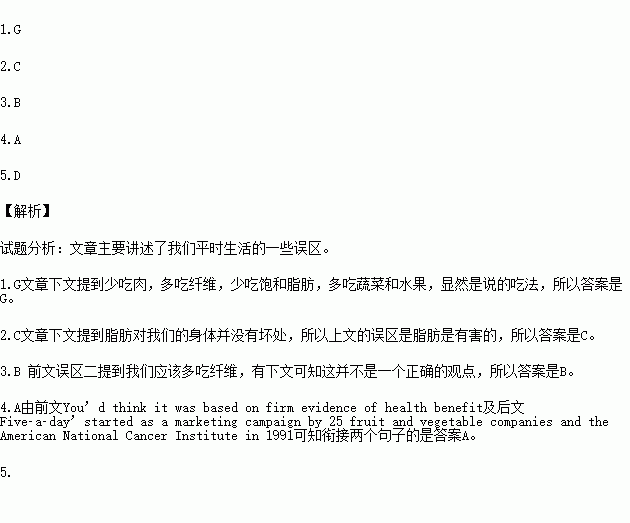题目内容
根据短文内容,从短文后的选项中选出能填入空白处的最佳选项。选项中有两项为多余选项。
_1.__: less red meat and more fiber, less saturated fat (饱和脂肪) and more fruit and vegetables, right? Wrong, according to a controversial new book by nutritionist Zoe Harcombe. In the book, Harcombe charts her careful journey of research into studies that underpin (巩固) dietary advice—and her myth(误区)-breaking conclusions are surprising.
Myth:__2.__.
“Real fat is not bad for us,”says Harcombe.“It’s man?made fats we should be demonizing.”Why do we have this idea that meat is full of saturated fat? In a 100g pork chop, there is 2.3g of unsaturated fat and 1.5g of saturated fat.
Myth: We should eat more fiber.
For three decades, we have eaten fiber into our bodies to help us feel full and keep our digestive systems moving.“__3.__”, says Harcombe.
The advice to eat more fiber is put forward along with the theory that we need to clean our digestive systems. But essential minerals are absorbed from food while it is in the intestines (肠道), so why do we want to wash everything out? Concentrate on not putting bad foods in.
Myth: You need to eat five portions of fruit and vegetables a day.
“Five?a?day is the most well-known piece of nutritional advice,” says Harcombe.“You’d think it was based on firm evidence of health benefit.__ 4.__.‘Five?a?day’started as a marketing campaign by 25 fruit and vegetable companies and the American National Cancer Institute in 1991.There was no evidence for any cancer benefit.”
Myth: Fruit and vegetables are the most nutritious things to eat.
Apparently not Harcombe allows that vegetables are a great addition to the diet—if served in butter to deliver the fat-soluble(dissolved) vitamins they contain—but natural sugar, the fruit sugar in fruit, goes straight to the liver and is stored as fat.“__5.__”, says Harcombe, who adds “Vitamins and minerals in animal foods—meat, fish, eggs and dairy products—beat those in fruit hands down.”
A.Think again
B.This is not a good idea
C.Fat is bad for us
D.Fruit is best avoided by those trying to lose weight
E.Want to lose weight? Don’t trust these
F.We need take more exercise
G.We think we know what to eat

